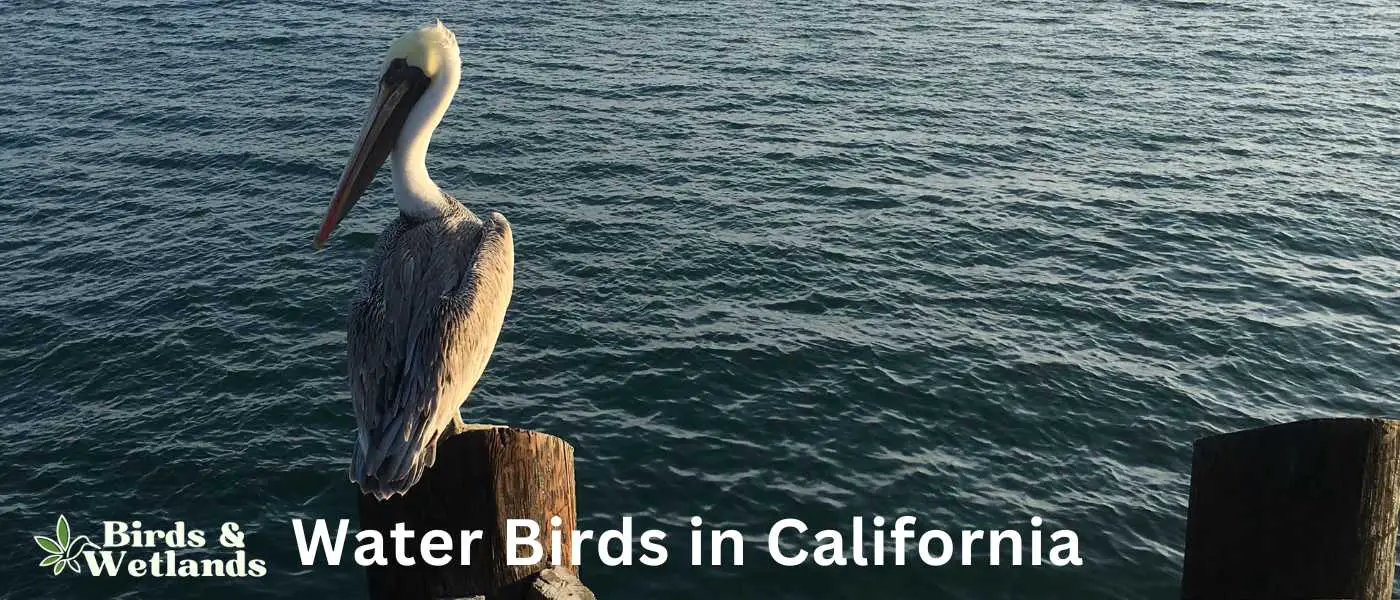California, with its diverse landscapes and numerous water bodies, is a haven for water bird enthusiasts. From the coastal regions bathed by the Pacific Ocean to the countless lakes and wetlands dotting its terrain, the state provides a diverse range of habitats that support a variety of water bird species.
California water birds
| Water Bird Species | Frequency in California | Specific Locations in California |
|---|---|---|
| American White Pelican | Common | Salton Sea, Mono Lake |
| Brown Pelican | Very Common | Coastal areas, particularly La Jolla |
| Western Grebe | Common | Clear Lake, Mono Lake |
| Clark’s Grebe | Common | Salton Sea, Lake Berryessa |
| American Coot | Very Common | Most inland waters |
| Double-Crested Cormorant | Very Common | San Francisco Bay, San Diego Bay |
| Brandt’s Cormorant | Common | Coastal areas, particularly Farallon Islands |
| Mallard | Very Common | Sacramento National Wildlife Refuge, Lake Merritt |
| Northern Pintail | Common | Merced National Wildlife Refuge, Sacramento River |
| Bufflehead | Uncommon | San Francisco Bay, Tule Lake |
| Snowy Egret | Common | San Joaquin Wildlife Sanctuary, Malibu Lagoon |
| Great Egret | Very Common | Tijuana Slough National Wildlife Refuge, Owens River |
| Great Blue Heron | Very Common | Shasta Lake, Lake Tahoe |
| Green Heron | Common | Santa Ana River, San Francisco Botanical Garden |
| Black-Crowned Night-Heron | Common | Lake Merritt, Bolsa Chica Ecological Reserve |
| White-Faced Ibis | Uncommon | Salton Sea, Kern National Wildlife Refuge |
| Greater Flamingo | Rare | Seen at San Francisco Zoo |
| California Gull | Very Common | Mono Lake, Salton Sea |
| Western Gull | Very Common | Coastal areas, particularly San Francisco Bay Area |
| Heermann’s Gull | Common | Coastal areas, particularly Monterey Bay |
| American Avocet | Common | San Francisco Bay, Salton Sea |
| Black-necked Stilt | Common | Don Edwards San Francisco Bay National Wildlife Refuge |
| Sandhill Crane | Uncommon | Consumnes River Preserve, Lodi |
| Greater Scaup | Uncommon | Humboldt Bay, San Francisco Bay |
| Ruddy Duck | Common | Clear Lake, Salton Sea |
| Northern Shoveler | Common | Sacramento National Wildlife Refuge, Lake Merritt |
| Surf Scoter | Uncommon | Monterey Bay, Humboldt Bay |
| Red-breasted Merganser | Common | San Francisco Bay, Humboldt Bay |
| Osprey | Common | Clear Lake, Lake Tahoe |
Water Bird Species Found in California
American White Pelican


| Feature | Measurement |
|---|---|
| Scientific Name | Pelecanus erythrorhynchos |
| Length | 50–70 in |
| Wingspan | 95–120 in |
| Weight | 3.5 and 13.6 kg |
The American White Pelican (Pelecanus erythrorhynchos) is one of North America’s largest birds, distinguished by its brilliant white plumage, elongated orange bill, and massive wingspan, which can extend up to 3 meters. This bird has a unique appearance with its distinctive pouch used for feeding and a “horn” on the upper part of the bill during the breeding season. Though a large bird, it is very graceful in flight, often seen soaring in flocks in a V formation.
American White Pelicans inhabit lakes, marshes, and salt bays, and despite their size, they are excellent swimmers. They feed primarily on fish, using a cooperative hunting strategy where they encircle schools of fish in shallow water and then scoop them up in their bill pouches. Unlike their brown pelican relatives, they do not dive for their food. During the breeding season, these pelicans will nest in colonies on islands in freshwater lakes.
Brown Pelican (Pelecanus occidentalis)


Listen:
Scientific Name: Pelecanus occidentalis
Length: 3 ft 3 in to 5 ft 0 in
Wingspan: 6 ft 8 in to 7 ft 6 in
Weight: 4.4 to 11.0 lb
The Brown Pelican is a large water bird famous for its distinct body shape and dramatic feeding habits. Known for their habit of diving headfirst into the water to catch fish, they are a staple along the coasts of the southern United States.
Appearance: Brown Pelicans are easily identifiable due to their long, curved necks, stout bodies, and large bills with a stretchy pouch. As their name suggests, they have brown and gray body feathers, with a paler head and neck that can become yellowish in breeding season.
Diet: Their diet mainly consists of fish, which they catch by making spectacular plunging dives from the air, scooping up the fish in their expandable bill pouches. They then drain the water from their pouches before swallowing their catch.
Reproduction: Brown Pelicans nest in colonies on islands, laying 2 to 3 eggs in nests made from sticks and vegetation. Both parents share incubation and feeding duties. After hatching, the chicks remain in the nest for around 12 weeks before they are ready to leave.
Western Grebe (Aechmophorus occidentalis)

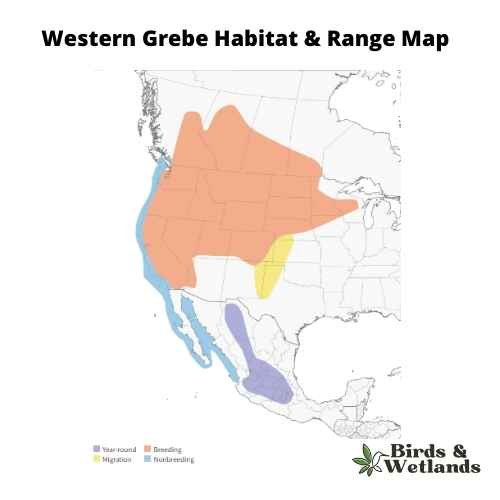
Listen:
Scientific Name: Aechmophorus occidentalis
Length:22–30 in
Wingspan: 31–40 in
Weight: 1.753–4.409 lb
The Western Grebe is a distinctive waterbird, celebrated for its elegant appearance and elaborate courtship dance.
Appearance: Western Grebes are large, long-necked grebes with pointed bills. They are mostly white underneath with dark gray to black coloration on the back, neck, and cap. A distinguishing feature is the red eyes which stand out against the black face.
Diet: Western Grebes primarily feed on fish, which they catch by diving underwater. Their long necks and sharp bills make them adept at spearing or grabbing their prey. In addition to fish, they also eat crustaceans, insects, and occasionally vegetation.
Reproduction: Western Grebes are monogamous and famous for their courtship display, known as the “rushing ceremony,” where two birds dance across the water’s surface. They build floating nests in colonies on the water, typically hidden among reeds. The female usually lays 2 to 4 eggs.
Clark’s Grebe (Aechmophorus clarkii)
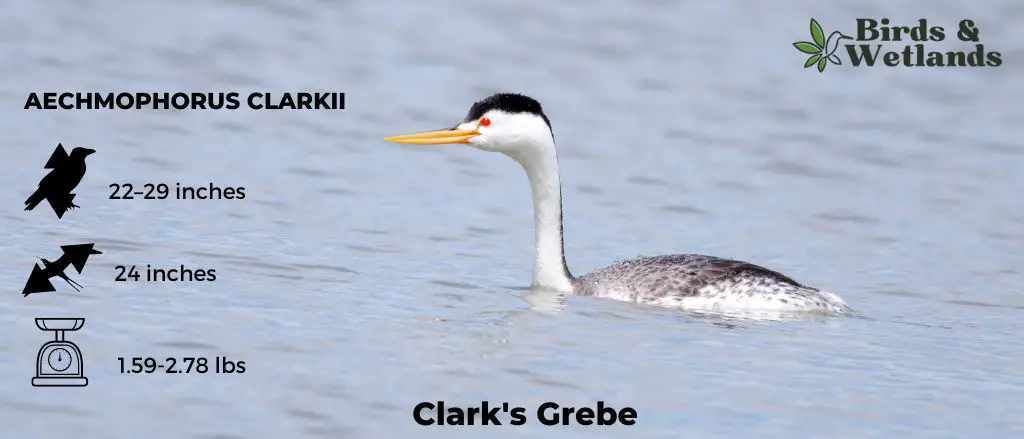

Listen:
Scientific Name: Aechmophorus clarkii
Length: 22–30 in
Wingspan: 24 in
Weight: 25.3–44.4 oz
The Clark’s Grebe is a striking waterbird, similar in size and behavior to the Western Grebe, but with notable differences in appearance.
Appearance: Clark’s Grebes are large grebes that are predominantly white with dark gray to black coloration on the back. Their necks are long and white, and they have a bright yellow bill, distinguishing them from the Western Grebe. Additionally, their eyes are red and are surrounded by white feathers.
Diet: Much like Western Grebes, Clark’s Grebes have a diet primarily composed of fish, which they catch by diving underwater. They use their long, sharp bills to snatch or spear their prey. Their diet can also include crustaceans and insects.
Reproduction: Clark’s Grebes are monogamous and share many breeding behaviors with the Western Grebe, including the famous “rushing” courtship display. They build floating nests among reeds on bodies of water. The female typically lays 3 to 4 eggs, with both parents participating in incubation and chick-rearing.
American Coot

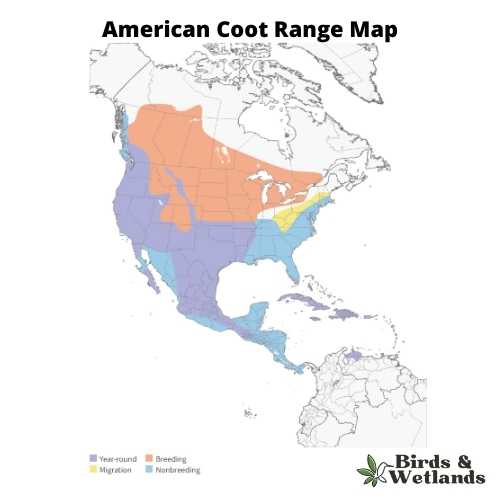
Listen:
Scientific Name: Fulica americana
Length: 13–17 in
Wingspan: 23 to 28 in
Weight: 1.270 to 1.870 lb
The American Coot is a ubiquitous water bird commonly seen in the wetlands, lakes, and ponds of North America, recognized for its adaptability and striking features.
Appearance: American Coots are easily identifiable by their slate-gray bodies, offset by a white, chicken-like bill and a red eye. Their legs are also distinctive, equipped with lobed toes, as opposed to the webbed feet seen in ducks, which assist them in navigating both land and water adeptly.
Diet: While aquatic plants form the bulk of an American Coot’s diet, they aren’t strictly herbivores. These versatile birds also consume small invertebrates and fish, demonstrating their ability to adapt and survive in a variety of habitats.
Reproduction: Nesting for the American Coot usually happens in shallow water bodies, where they construct a floating nest hidden among the vegetation. A clutch can contain between 8 to 12 eggs, all of which are incubated by both parents.
Double-crested cormorant


| Feature | Measurement |
|---|---|
| Scientific Name | Nannopterum auritum |
| Length | 28–35 in |
| Wingspan | 45–48 in |
| Weight | 1.2–2.5 kg |
The Double-Crested Cormorant (Phalacrocorax auritus) is a large waterbird known for its long neck, hooked bill, and almost entirely black body. The species gets its name from the two small patches of tufted feathers or “crests” found on the heads of breeding adults, one on each side. These birds are strong swimmers that propel themselves underwater with their webbed feet, their bodies submerged and necks above the water surface, giving them a characteristic snake-like appearance when swimming.
Double-Crested Cormorants are widely distributed across North America and can be found in a variety of aquatic environments including freshwater lakes, coastal areas, and rivers. Their diet primarily consists of fish, which they catch by diving from the water’s surface. Often seen perched with wings outstretched to dry after fishing, these cormorants nest in trees, on the ground, or on cliff edges, usually in colonies. While they have rebounded from decreases in the mid-20th century due to DDT-related reproductive failures, they face ongoing threats from habitat loss, entanglement in fishing gear, and conflicts with fisheries over their consumption of fish. Protection and careful management of their habitats are key to their ongoing conservation.
Brandt’s Cormorant (Phalacrocorax penicillatus)
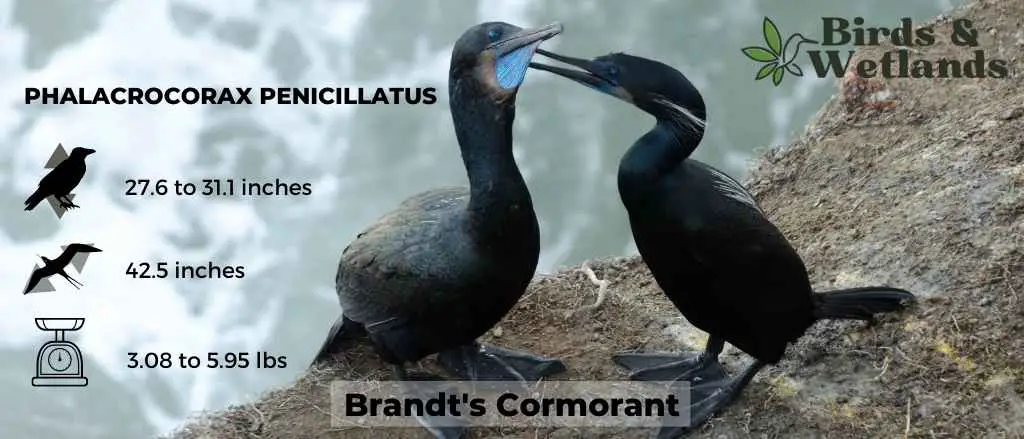
The Brandt’s Cormorant is an intelligent bird that can be trained as a pet or to perform tricks. The species is also known to have a good sense of direction, which helps it migrate thousands of miles each year.
- Scientific Name: Phalacrocorax penicillatus
- Length: 27.6-31.1 in (70-79 cm)
- Wingspan: 42.5 in (108 cm)
- Weight: 49.4-95.2 oz (1400-2700 g)
Brandt’s Cormorant Description
Brandt’s cormorants are medium-sized birds, with a black body and white underparts. Their wings are dark gray with white tips, and their head is black with a yellow bill and orange eyes. They are known for their sleek bodies and long, pointed beaks. They also have webbed feet that allow them to swim extremely fast through the water.
Brandt’s Cormorant Sound
Brandt’s Cormorant Habitat & Range
Brandt’s cormorants live along both sides of the Pacific Ocean in North America and Asia. They prefer shallow waters where they can easily find food and avoid predators.
They are most often seen in shallow waters near shore feeding on fish.

Brandt’s Cormorant Diet
Brandt’s cormorants eat fish, shrimp, crabs, mollusks, worms, crustaceans and other aquatic organisms found in rivers or oceans near their nesting sites. Some young birds may also eat insects during migration periods when there isn’t enough food available nearby yet! It can take up to six hours for these birds to digest their meals.
Brandt’s Cormorant Nesting
Brandt’s Cormorants have been observed nesting on cliffs throughout their range from Canada to Japan, but they also nest on rocks at sea level or even on land if there are no suitable cliffs available nearby. The breeding season for Brandt’s Cormorant is from May to July. They breed in colonies of several hundred pairs on cliffs or offshore islands, but they may also nest on the ground or in trees.
Mallard


| Feature | Measurement |
|---|---|
| Scientific Name | Anas platyrhynchos |
| Length | 20-26 inches |
| Wingspan | 32-39 inches |
| Weight | 1.6-3.5 pounds |
The Mallard, one of the most recognizable of all ducks, is distinguished by its classic “quack” and its common presence in city parks and wild wetlands.
Appearance: Mallards are large ducks with a hefty body and rounded head. The male is notable for its glossy green head, gray body, and black tail-curl, while the female is mottled brown with an orange-brown bill. Both sexes have a white-bordered, blue “speculum” patch in the wing.
Diet: Mallards are omnivorous, dabbling ducks that eat a wide variety of foods. They are known to feed on aquatic vegetation, insects, worms, and grains. In city parks, they are often seen eating bread, popcorn, and other food provided by humans, although such items are not part of their natural diet.
Reproduction: Mallards nest on the ground on dry land that is close to water, under cover of tall grass or other vegetation. The female typically lays around 8 to 13 eggs and incubates them herself.
Northern Pintail

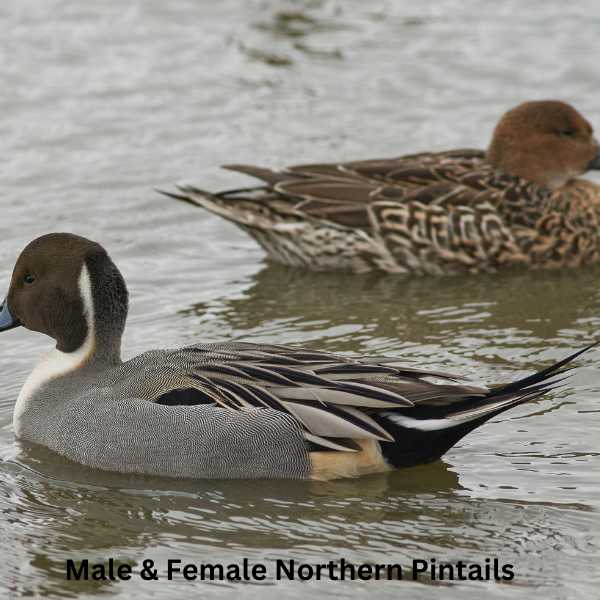
Listen to Northern Pintail
Scientific Name: Anas acuta
Length: 23–30 in
Wingspan: 31–37 in
Weight: 1 –3 lb
The Northern Pintail is a graceful species of duck recognized for their elegance in flight and their sleek bodies and long tails which is pin-shaped.
Male Northern Pintails are celebrated for their distinctive appearance, featuring a chocolate brown head, a white neck, and a grayish body. The most notable characteristic is the long, pointed tail feathers, which give this species its name. Females are more understated in color, sporting a mottled brown plumage.
Diet: Consists primarily of plant matter, including seeds and aquatic vegetation. They are also known to eat insects, especially during the breeding season. The Northern Pintail is often seen dabbling and upending in water bodies to forage for food.
Reproduction: Northern Pintails usually nest on the ground, near water bodies. The female lays a clutch of 7 to 9 eggs and is solely responsible for their incubation, which lasts for about three weeks.
Bufflehead


Listen to Bufflehead
Scientific Name: Bucephala albeola
Length: 13–16 in
Wingspan: 21.6 in -23.2 in
Weight: 9.5–19.4 oz
The Bufflehead is a small, compact species of diving duck known for its striking appearance and large heads and unique nesting habits.
Appearance: Male Buffleheads are easily recognized by their large, bulbous head with a green-purple iridescent sheen, a large white patch across the back of the head, and a predominantly black and white body. Females are more subtly colored, primarily in gray-brown tones with a smaller white cheek patch.
Diet: As diving ducks, Buffleheads feed by diving beneath the water’s surface. Their diet consists largely of aquatic invertebrates, such as insects, crustaceans, and mollusks, as well as some plant matter.
Reproduction: Uniquely among ducks, Buffleheads often nest in tree cavities, especially those made by Northern Flickers, a type of woodpecker. The female lays a clutch of about 6 to 11 eggs, which she incubates alone for roughly a month.
Snowy Egret

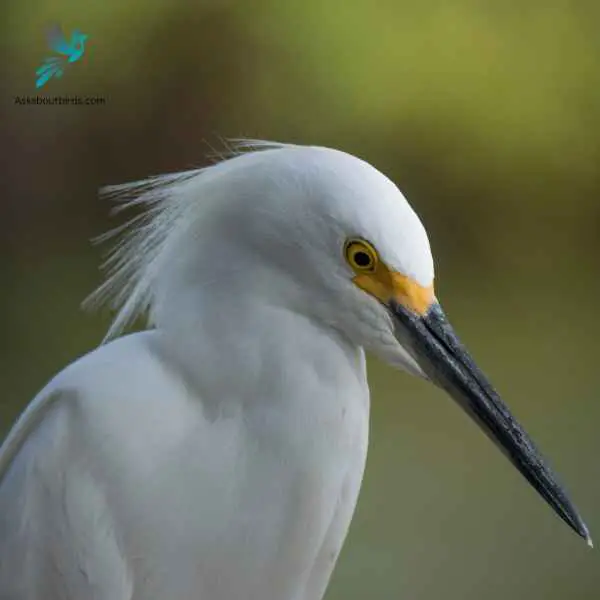
| Feature | Measurement |
|---|---|
| Scientific Name | Egretta thula |
| Length | 22.1–26.0 in |
| Wingspan | 39.4 in |
| Weight | 370 g |
The Snowy Egret (Egretta thula) is a small and active wading bird, celebrated for its delicate beauty. It sports an entirely white plumage that appears to glow against its black bill and legs, and striking yellow feet, which often play a crucial role in luring prey during feeding.
The Snowy Egret is further adorned with fine, plume-like feathers on its head, neck, and back during the breeding season, making it one of the more distinctive heron species.
Inhabiting wetland areas across the Americas, the Snowy Egret can be found in marshes, swamps, shorelines, and tidal flats where it feeds primarily on fish, but also consumes insects, crustaceans, and small reptiles.
Great Egret


| Feature | Measurement |
|---|---|
| Scientific Name | Ardea alba |
| Length | 31 to 41 in |
| Wingspan | 52 to 67 in |
| Weight | 1.5 to 3.3 lbs |
The Great Egret (Ardea alba), also known as the Common Egret, is a large, elegant wading bird recognized for its brilliant white plumage, slender black legs, and long, dagger-like yellow bill.
With a height of up to 3.3 feet and a wingspan of 52 to 67 inches, this bird is amongst the largest of the heron species. Its stately appearance and serene comportment have made it a popular symbol in many cultures and an eye-catching sight in its habitats.
Found across all continents except Antarctica, the Great Egret resides in both fresh and saltwater wetlands, including marshes, ponds, and coastal areas. It feeds mainly on fish, but it also hunts amphibians, small mammals, and invertebrates.
Great Blue Heron


| Feature | Measurement |
|---|---|
| Scientific Name | Ardea herodias |
| Length | 36–54 in |
| Wingspan | 66–79 in |
| Weight | 1.82–3.6 kgs |
Great Blue Herons are the largest heron species in North America, is distinguished by its tall stature and unique blue-gray plumage.
Measuring up to 4.5 feet tall with a wingspan of approximately 6.5 feet, the bird features a long, pointed bill, a white head with a black eye stripe extending to slender black plumes, and robust, elongated legs. Its distinctive flight pattern, forming a tight “S” shape with its neck, sets it apart from similar large birds, like cranes.
Inhabiting various wetland habitats, including marshes, lakes, rivers, and coastal regions throughout much of North and Central America, the Great Blue Heron is a wading bird. Often seen poised statue-like at the water’s edge, these birds are expert hunters, spearing fish and capturing small animals with their sharp bills.
Green Heron


| Feature | Measurement |
|---|---|
| Scientific Name | Butorides virescens |
| Length | 16-18 inches |
| Wingspan | 25-27 inches |
| Weight | 6-7 ounces |
The Green Heron is a small heron found in North America, notable for its deep green back and chestnut body, as well as its unique fishing tactics.
Appearance: Green Herons are dark and compact birds with a glossy, greenish-black cap, a greenish back and wings, and chestnut neck and belly. The bill is long, dark and sharply pointed. Their legs are bright orange or yellow. Young birds are duller in color, with a dark top and streaked brown front.
Diet: The Green Heron’s diet is quite varied, consisting mostly of small fish, but also includes insects, spiders, and sometimes amphibians and small mammals. It’s known for its tool-using behavior where it drops bait onto the water’s surface to attract fish.
Reproduction: Green Herons are solitary birds except during the breeding season, where they form monogamous pairs. Nests are typically built in trees or shrubs near water. Females lay 2 to 5 pale blue-green eggs that both parents incubate.
Black-Crowned Night-Heron
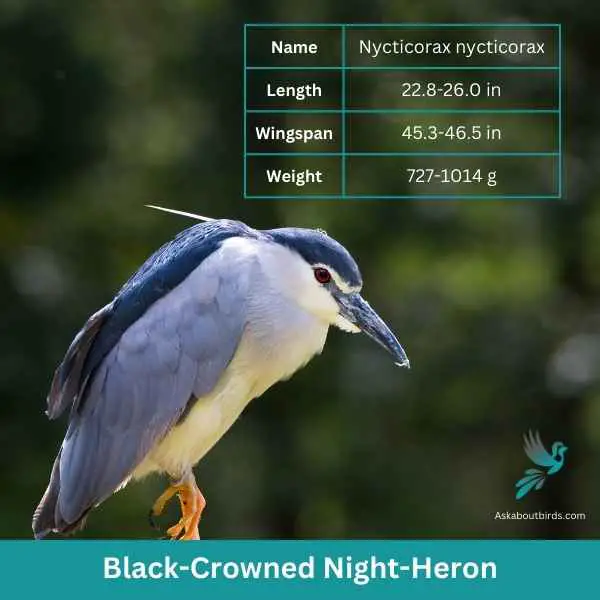

| Feature | Measurement |
|---|---|
| Scientific Name | Nycticorax nycticorax |
| Length | 22.8-26.0 in |
| Wingspan | 45.3-46.5 in |
| Weight | 727-1014 g |
The Black-Crowned Night-Heron (Nycticorax nycticorax) is a medium-sized heron species known for its distinct nocturnal habits and characteristic appearance. The bird displays a stocky silhouette, with a black crown and back, contrasting starkly with its light grey wings and white underparts.
Its eyes are large and red, adapted for its night-time activities, and its legs are relatively short for a heron. The bill is sturdy and black, and during the breeding season, two to three long white plumes extend from the back of the head.
Residing in a wide variety of wetland habitats, from freshwater marshes to coastal regions, the Black-Crowned Night-Heron is found across a large global range, including the Americas, Europe, Asia, and Africa. The species primarily feeds on fish and invertebrates, but it is known to be opportunistic and will also eat small mammals, birds, and eggs.
White-faced Ibis
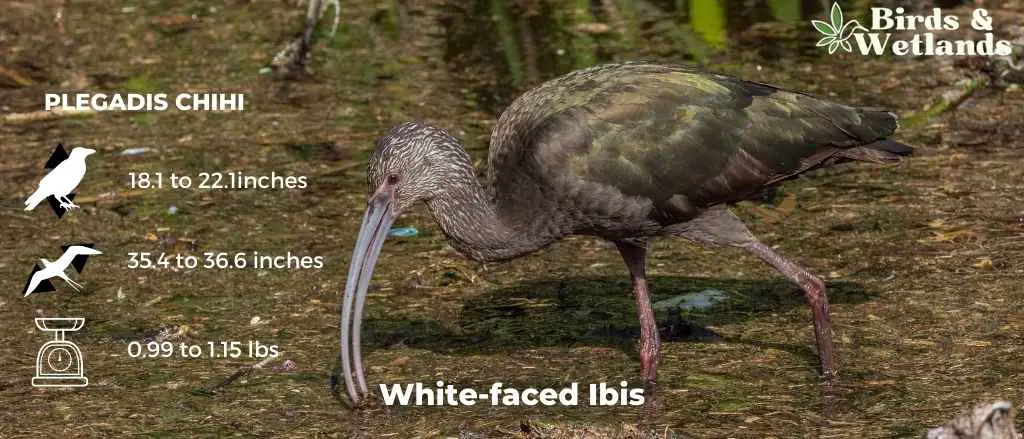
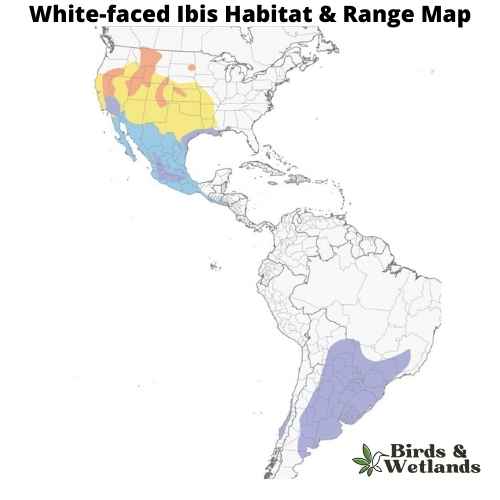
Listen
Scientific Name: Plegadis chihi
Length: 18.1-22.1 in
Wingspan: 35.4-36.6 in
Weight: 15.9-18.5 oz
The White-faced Ibis is a wading bird that is most commonly found in the marshes, swamps, and wetlands of the Western United States.
Appearance: The White-faced Ibis stands out for its iridescent dark red-brown body, a slim and curved bill, and long grayish legs. Its name comes from a distinguishing feature seen in adults – a thin band of white feathers around the base of the bill and eye during the breeding season. Its eyes are reddish, which further adds to its distinctive appearance.
Diet: The diet of the White-faced Ibis primarily consists of insects, crustaceans, snails, and small fish. With their long, curved bills, they probe into the soft mud in search of these food items.
Reproduction: The White-faced Ibis typically builds its nest in low shrubs or trees near water bodies, using sticks and other vegetation. It lays a clutch of 3 to 5 eggs that are light blue in color. Both parents share the responsibility of incubating the eggs for about three weeks.
Greater Flamingo (Phoenicopterus roseus)
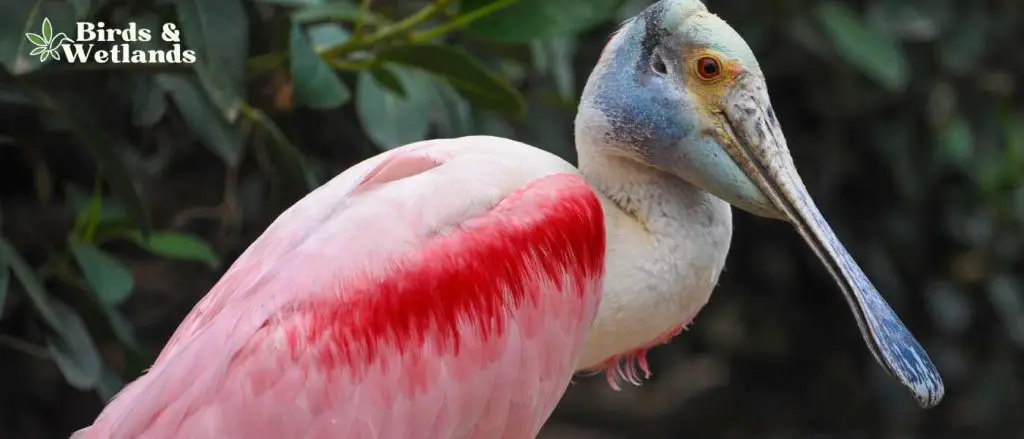
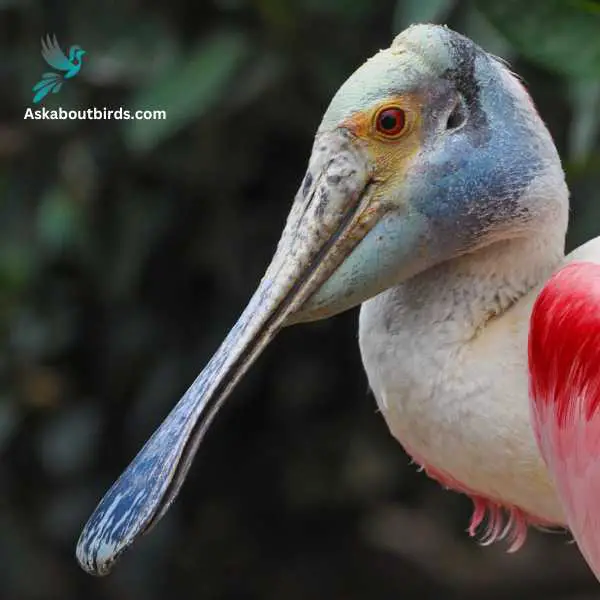
Scientific Name: Phoenicopterus roseus
Average Length: 110 – 150 cm (43 – 59 in)
Average Wingspan: 140 – 165 cm (55 – 65 in)
Average Weight: 2 – 4 kg (4.4 – 8.8 lbs)
The Greater Flamingo is the largest and most widespread species of the flamingo family, instantly recognizable by its long, thin neck and legs, and its vibrant pink feathers.
Appearance: Greater Flamingos have a distinct appearance, characterized by their long, curved neck, sticklike legs, and pinkish-white feathers. Their bill is pink with a distinctive black tip. The legs are also pink, adding to their flamboyant look. They are the largest flamingo species, standing about 3.9 to 4.7 feet tall.
Diet: Greater Flamingos primarily feed on small organisms like crustaceans, mollusks, and microscopic algae. They use their unique, specially adapted beak to filter these tiny creatures from the water. The pink coloration of their feathers comes from pigments in the crustaceans and algae they eat.
Reproduction: Greater Flamingos are monogamous birds that breed in large colonies, sometimes numbering thousands of pairs. They build mounded nests from mud where the female lays a single egg. Both parents share the responsibility of incubation, which lasts around 30 days. The young flamingo is fed a nutritious milk-like substance produced by both parents.
California Gull (Larus californicus)
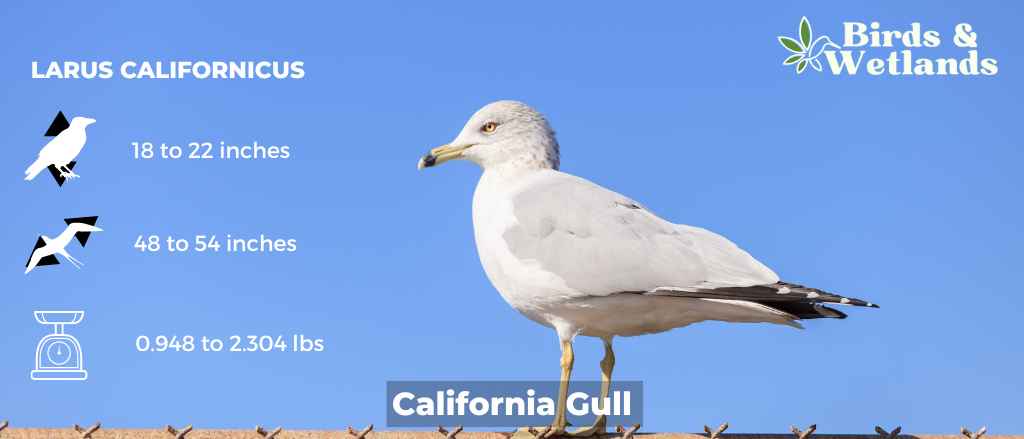
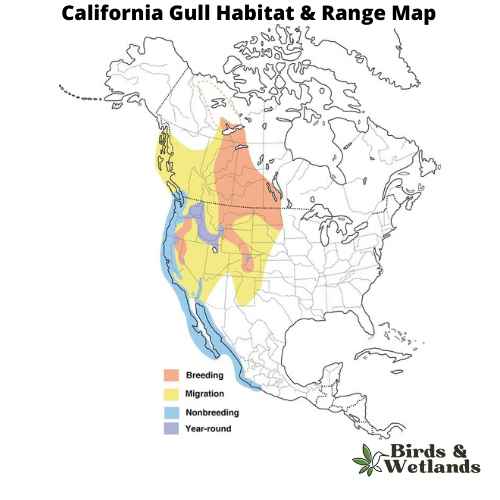
Listen:
Scientific Name: Larus californicus
Average Length: 18 to 22 in
Average Wingspan: 48–54 in
Average Weight: 0.948 to 2.304 lb
The California Gull is a medium-sized gull species known for its adaptable nature and interesting feeding habits. This gull is known to inhabit a wide range of habitats, including coastlines, lakes, and even garbage dumps in cities.
Appearance: California Gulls are medium-sized birds with a white body, gray wings, and a yellow bill with a distinctive black ring around it. Their legs and feet are greenish-yellow. One interesting aspect of their appearance is their eyes, which are a pale yellow color.
Diet: California Gulls have a very diverse diet. They are known to eat fish, insects, small mammals, eggs, garbage, and sometimes even other birds. They are opportunistic feeders and will consume whatever food is readily available.
Reproduction: These gulls are monogamous, and they breed in colonies, usually on islands in lakes or on the coast. The female lays 2 to 3 eggs in a shallow ground nest made of twigs, grass, and feathers.
Western Gull (Larus occidentalis)
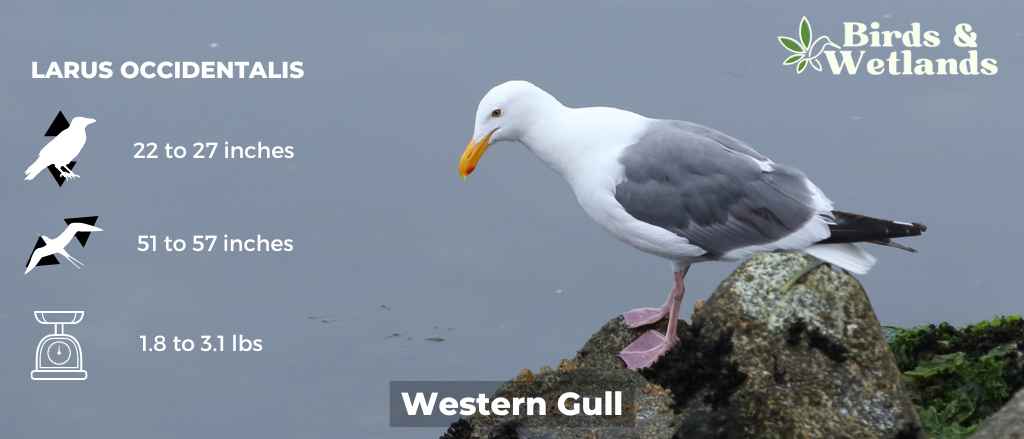
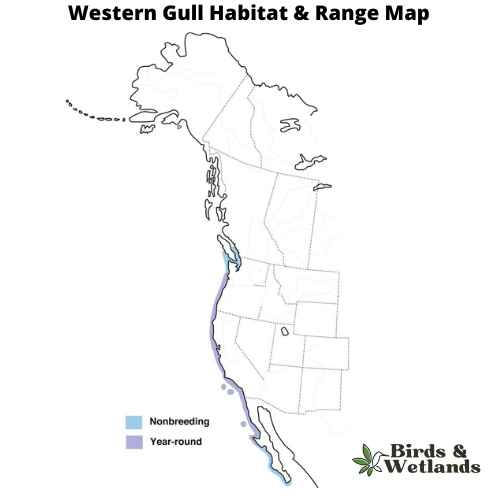
Listen:
Scientific Name: Larus occidentalis
Average Length: 22 to 27 in
Average Wingspan: 51 to 57 in
Average Weight: 1.8 to 3.1 lb
The Western Gull is a large species of sea bird native to the west coast of North America. They are highly adaptable and can be seen from the coastal areas to urban environments, demonstrating resilience and adaptability.
Appearance: Western Gulls are sizable birds featuring a white head and underparts, with a dark gray to black back and wings. They have yellow eyes and a robust, yellow bill marked with a red spot near the tip. Their legs and feet are pinkish in color.
Diet: Western Gulls are opportunistic eaters with a varied diet. They consume a range of food items such as fish, marine invertebrates, eggs, small birds, and carrion. They have also been known to frequent human-inhabited areas, scavenging on discarded food and garbage.
Reproduction: The Western Gull is a colonial nester, typically establishing nesting sites on islands, cliffs, and even rooftops in urban areas. They lay a clutch of 1 to 3 eggs, which are incubated by both parents for about a month.
Heermann’s Gull (Larus heermanni)
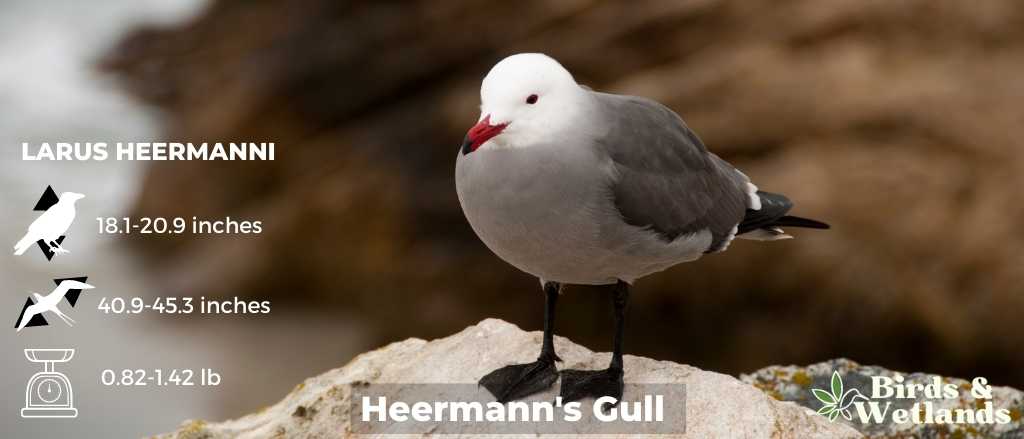
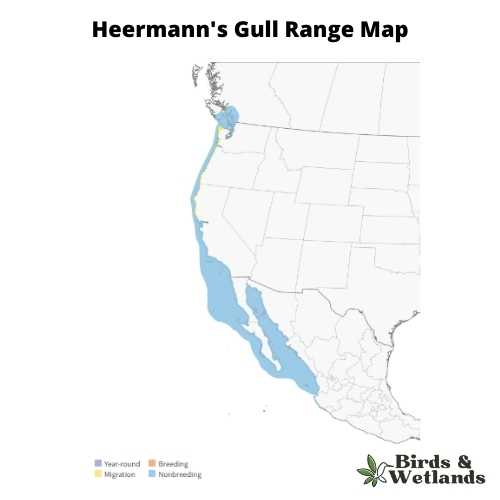
Listen:
Scientific Name: Larus heermanni
Average Length: 18.1-20.9 in
Average Wingspan: 40.9-45.3 in
Average Weight: 13.1-22.7 oz
The Heermann’s Gull is a striking seabird endemic to the Pacific coast of North America. Known for their bold interactions with humans, they are a distinctive sight along the coastline.
Appearance: Heermann’s Gulls possess a sleek, gray body with a white head and a distinctive red bill with a black tip. In contrast to many gull species, their legs are also red. Adult Heermann’s Gulls exhibit a dark, smoky gray plumage that, along with their red bill, makes them easy to identify.
Diet: Like many gulls, Heermann’s Gulls are opportunistic feeders. Their diet is varied and includes fish, squid, and other marine life. They have also been known to scavenge from humans and are often seen in harbors and beach areas seeking food.
Reproduction: Heermann’s Gulls breed in colonies on islands off the coast of Mexico. They build nests on the ground and usually lay two or three eggs.
American Avocet

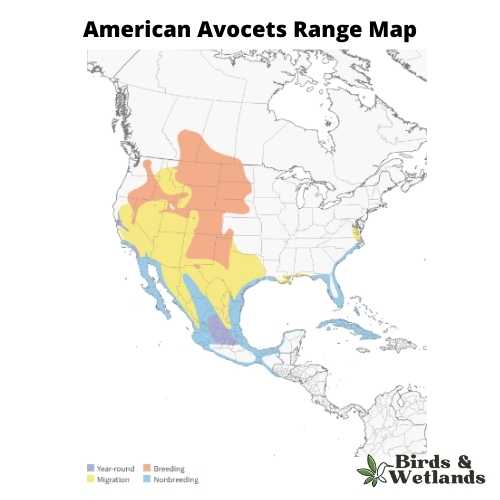
Listen:
Scientific Name: Recurvirostra americana
Length: 16–20 in
Wingspan: 27–30 in
Weight: 9.7–14.8 oz
The American Avocet is a distinctive wading bird known for its upturned bill and elegant profile.
Appearance: American Avocets have a unique look with a black and white body, a cinnamon colored neck and head in the summer, and a long, thin, upcurved bill. In winter, the bird’s neck and head turn grayish-white.
Diet: The diet of American Avocets primarily includes aquatic invertebrates, such as crustaceans and insects. They feed by sweeping their bill from side to side in the water to capture food.
Reproduction: American Avocets often nest in colonies, preferring to build their nests on open ground near water. The female typically lays a clutch of about 3 to 4 eggs, which are incubated by both parents.
Black-necked Stilt
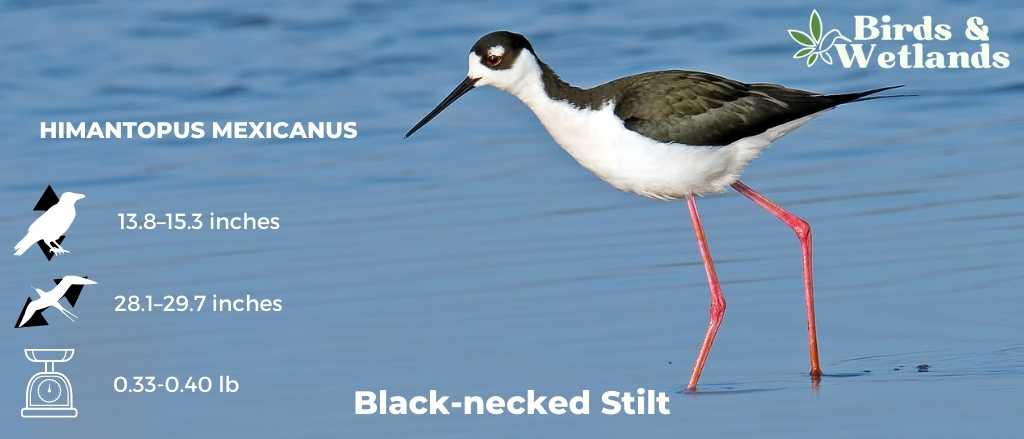
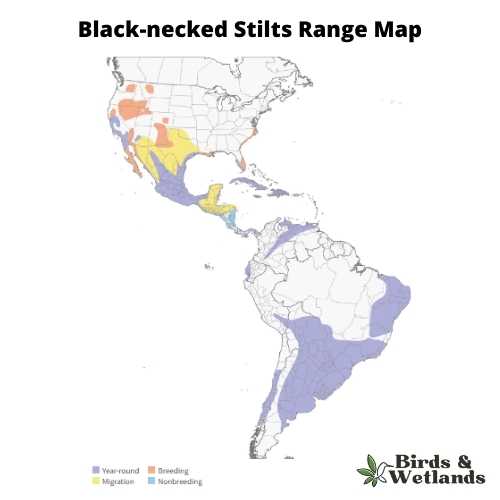
Listen:
Scientific Name: Himantopus mexicanus
Length: 13.8–15.3 in
Wingspan: 28.1–29.7 in
Weight: 5.3–6.2 oz
The Black-necked Stilt is a distinctively shaped wader known for its long, slender legs and striking color contrast.
Appearance: Black-necked Stilts exhibit a sharp contrast between their black upperparts – head, neck, and back – and their white underparts. They have very long, thin, pink legs and a long, thin, straight black bill.
Diet: Black-necked Stilts primarily feed on aquatic invertebrates such as insects, crustaceans, and mollusks. They forage in shallow water, often sweeping their bills from side to side to detect prey.
Reproduction: Black-necked Stilts nest on the ground, often near water. The female usually lays a clutch of about 3 to 5 eggs, which are incubated by both parents.
Sandhill Crane


Listen:
Scientific Name: Antigone canadensis
Length: 2 ft 7-4 ft 6 in
Wingspan: 16.5–23.6 in
Weight: 4 – 4.5 kg
The Sandhill Crane is a tall, elegant bird known for its impressive size and striking appearance. They are found across North America, in habitats ranging from wetlands to grasslands.
Appearance: Sandhill Cranes are recognized for their tall stature, gray body, long legs, and long neck. Their most distinctive feature is a red forehead, which contrasts with their otherwise primarily gray plumage. During the breeding season, their gray feathers often take on a rusty-brown hue due to them rubbing iron-rich mud onto their feathers.
Diet: Sandhill Cranes are omnivorous birds and their diet is quite diverse, consisting of seeds, grains, berries, insects, small mammals, reptiles, and amphibians. They are known to forage while walking in shallow water or in fields.
Reproduction: Sandhill Cranes mate for life and their complex courtship dance is a sight to behold. They nest in marshy areas and the female typically lays two eggs.

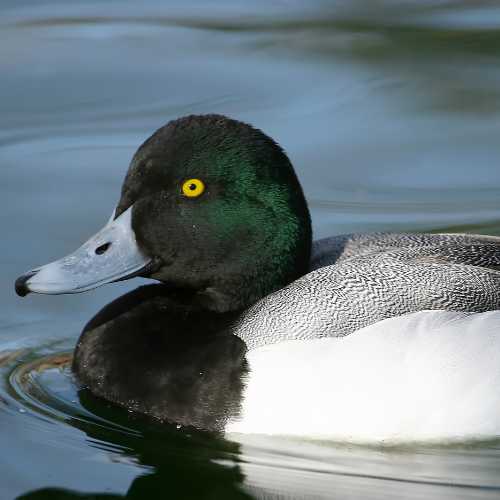
Listen:
Scientific Name: Aythya marila
Length: 15–22 in
Wingspan: 28–33 in
Weight: 1.601–2.998 lb
The Greater Scaup is a diving duck species found across North America, Europe, and Asia. This hardy bird is known for its preference for colder climates and ability to dive to impressive depths in search of food.
Appearance: The male Greater Scaup has a striking black head, neck, and chest, contrasted by a pale gray back and a white underbelly. Their heads have a greenish iridescence, and they have a blue-gray bill. Females, on the other hand, have a brown body with a white band at the base of the bill.
Diet: Greater Scaups are diving ducks and are capable of reaching depths of up to 6 meters to forage. Their diet primarily consists of aquatic invertebrates, such as mollusks and crustaceans, though they also consume plant matter including seeds and aquatic vegetation.
Reproduction: Greater Scaups breed in the northernmost parts of North America and Eurasia. They build nests on the ground near water, often on islands in lakes, shielded by vegetation. The female lays a clutch of around 9 eggs, and is solely responsible for incubation, which lasts about 24 to 28 days.
Ruddy Duck

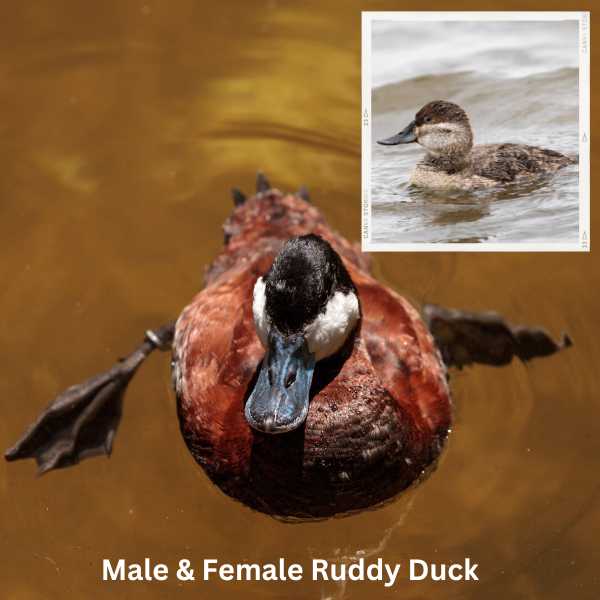
Listen
Scientific Name: Oxyura jamaicensis
Length: 13.8-16.9 in
Wingspan: 22.1-24.4 in
Weight: 10.6-30.0 o
The Ruddy Duck is a compact diving duck species recognized for its bright blue bill and stiff tail that is often held upright. These small, agile birds are found in wetlands and ponds across the United States.
Appearance: Ruddy Ducks are characterized by their distinct reddish-brown plumage, a blackish cap and nape, and a strikingly blue bill in males. The females are less vibrant, with gray-brown feathers and a dark bill. Both genders display a unique, spiky tail that often sticks upright, especially during courtship displays.
Diet: Ruddy Ducks primarily feed on a diet of aquatic invertebrates such as insects, crustaceans, and mollusks. They also consume a variety of aquatic plants and seeds. Their specialized bill allows them to sift through the water and mud to find food.
Reproduction: Ruddy Ducks nest in marshes and ponds with dense vegetation. The female typically lays a clutch of 6 to 10 eggs in a well-concealed nest built from plant material and down.
Northern Shoveler

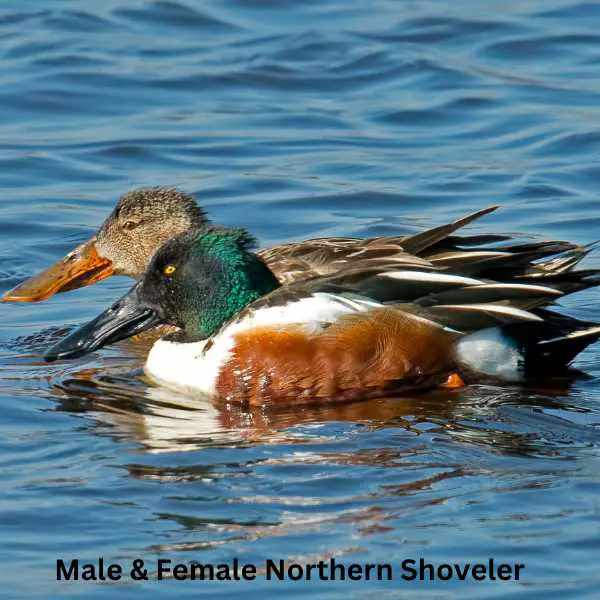
Listen to Northern Shoveler
Scientific Name: Spatula clypeata
Length: 16 in
Wingspan: 22 in
Weight: 14 oz
The Northern Shoveler is a distinct species of dabbling duck celebrated for its long, spoon-shaped bill, a feature that sets it apart from other ducks and gives the bird its name.
Appearance: Male Northern Shovelers are particularly striking, boasting a green head, yellow eyes, a large black bill, and a white chest, complemented by a chestnut-colored body. Females, on the other hand, feature a more muted color scheme, primarily displaying mottled brown feathers across their bodies and a slate-gray bill.
Diet: The Northern Shoveler’s unique bill is perfectly adapted for its feeding habits. The edges of the bill are furnished with comb-like structures that enable the bird to filter food from water. Their diet predominantly consists of aquatic invertebrates and plant matter, including seeds and algae.
Reproduction: Northern Shovelers typically nest on the ground, concealed within dense, grassy areas close to water bodies. The female lays a clutch of about 9 to 12 eggs and is solely responsible for their incubation, which lasts for about three to four weeks.

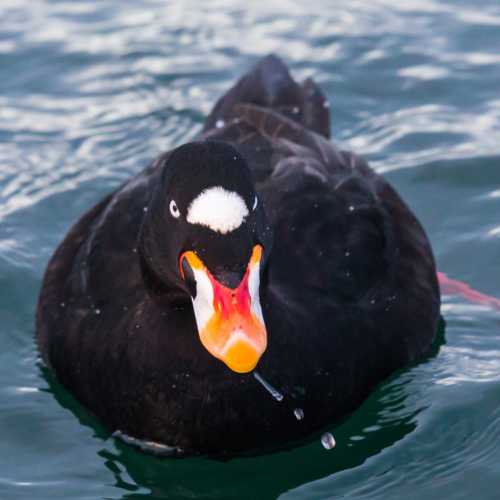
Listen
Scientific Name: Melanitta perspicillata
Length: 19 in
Wingspan: 29.9-30.3 in
Weight: 2.31 lb
The Surf Scoter is a distinctive sea duck species predominantly found along the coasts of North America. It’s recognized for its strong, fast flight and gregarious nature, often seen in large flocks.
Appearance: Male Surf Scoters are mainly black with a unique multicolored head – white patches on the forehead and nape, and a large, brightly colored bill with red, yellow, and white shades. Females, conversely, have a more subdued brownish body, with two pale patches on the cheek and at the base of the bill. They also have a dark cap on their heads.
Diet: Surf Scoters primarily feed on a diet of mollusks, crustaceans, and small fish. They’re skilled divers, capable of reaching significant depths to capture their prey. Occasionally, they also consume aquatic plants and insects.
Reproduction: Surf Scoters breed in the freshwater lakes and ponds of the northern boreal forests and tundra. The nest, built by the female, is usually situated close to water and is a simple depression lined with plant material and down. She lays a clutch of 5 to 9 eggs and incubates them for about a month.
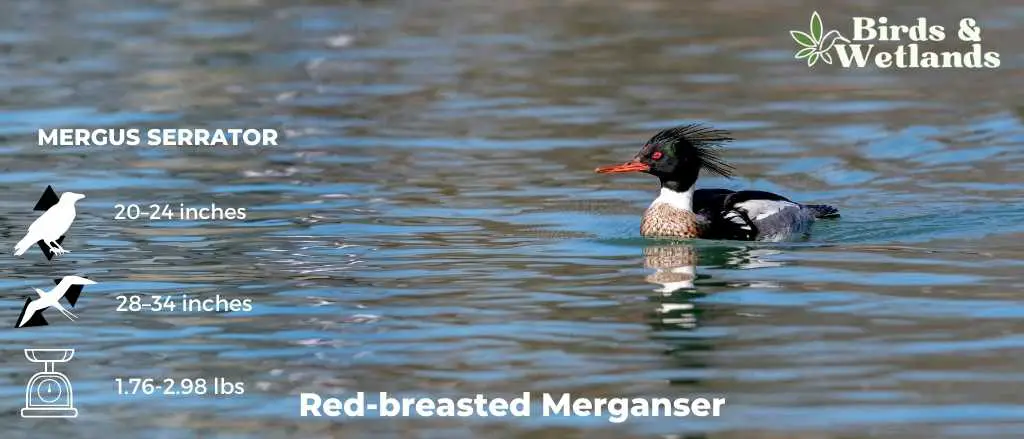

Listen
Scientific Name: Mergus serrator
Length: 20–24 in
Wingspan: 28–34 in
Weight: 28.2 to 47.6 oz
The Red-breasted Merganser is a fascinating diving duck species, recognized for its swift flight and exceptional diving capabilities. They inhabit freshwater and saltwater environments and are quite common in North America and Eurasia.
Appearance: The Red-breasted Merganser boasts an interesting appearance. Males display a dark green head, bright red eyes, and a distinctive, long reddish-brown breast. Their bodies are mainly grey, and they also have a white collar and a thin, serrated bill. Females are more subdued, featuring a rusty cinnamon head with a shaggy crest and grey body.
Diet: Predominantly includes small fish, which they catch by diving underwater. They can also feed on aquatic insects, crustaceans, and occasionally amphibians. Their serrated bill helps them grip slippery prey effectively.
Reproduction: The breeding ground for Red-breasted Mergansers is typically near freshwater lakes or rivers. Females build nests in tree cavities, on the ground hidden in vegetation, or use abandoned nests of other birds. The female lays a clutch of 6 to 12 eggs.
Osprey (Pandion haliaetus)

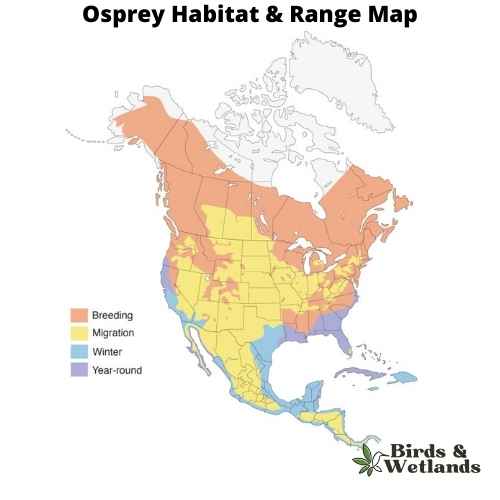
Osprey Sound
Scientific Name: Pandion haliaetus
Length: 50–66 cm (19+1⁄2–26 in)
Wingspan: 127–180 cm (50–71 in)
Weight: 0.9–2.1 kg (2 lb 0 oz – 4 lb 10 oz)
The Osprey, a fascinating bird of prey, is universally known for its exceptional hunting prowess and striking physical characteristics. Osprey are dark brown hawks on the upperparts, contrasting beautifully with the predominantly white underparts, and a distinctive dark band that stretches across the eyes towards the sides of its head.
Equipped with specialized talons and a reversible outer toe, the Osprey’s hunting strategy involves a spectacular plunge-dive into bodies of water, often emerging with a fish securely gripped in its claws.
Found on every continent except Antarctica, the Osprey is a cosmopolitan species favoring habitats near water bodies such as lakes, rivers, and coastal areas, reflecting its piscivorous diet. This bird has a diet almost exclusively of fish, making it a unique member of the raptor family and often referred to as the sea hawk or fish hawk. They locate their prey from the air, often hovering before plunging feet-first to capture a fish. When it comes to breeding, Ospreys are monogamous, often mating for life.
They construct large, bulky nests made of sticks, lined with softer materials, and prefer elevated or isolated areas such as treetops or artificial structures like utility poles. Both parents share the responsibility of incubating the eggs and rearing the chicks.
Where to Spot California’s Water Birds
Salton Sea: Located in the southeastern part of California, this is the largest lake in the state. Salton Sea provides a critical habitat for over 400 bird species, including the American White Pelican, making it a haven for bird watchers. Its large surface area and ecological richness make it an ideal stopover for migratory birds.
San Francisco Bay: Known for its rich estuaries, it’s a prime location to spot Double-Crested Cormorants, American Avocets, and other waterfowl. The Don Edwards San Francisco Bay National Wildlife Refuge is a particular hotspot, where you can find diverse bird species year-round.
Mono Lake: This ancient saline lake located in Mono County is famous for its tufa towers. The lake is a crucial nesting habitat for California Gulls and is also known for its population of phalaropes and grebes. Its unique ecological features provide a haven for various bird species.
Sacramento National Wildlife Refuge: The refuge offers a great diversity of bird species, especially during winter. Northern Pintails, Greater Scaups, and White-Faced Ibises are among the species seen here. The refuge’s wetlands, grasslands, and riparian habitats support a myriad of water birds.
Point Reyes National Seashore: Located on the Point Reyes Peninsula in Marin County, this site is a significant stop on the Pacific Flyway migration route. More than 490 bird species have been observed in this area, making it one of the bird-watching hotspots in California. You can observe a variety of water birds here, including egrets, herons, and ducks.
There are literally hundreds of waterbirds in California, everything from the green winged teal to the blue winged teal, wood ducks, mute swans with their distinctive orange bill, canada goose and cattle egrets just to name a few. The wood duck is a medium sized water bird often found on the inland wetlands. The beauty of California is the diverse water sources from wetland habitat including shallow wetlands to oceans providing a very diverse range of birds.
| Neighboring State | Best Spots for Birdwatching |
|---|---|
| Oregon Water Birds | Malheur National Wildlife Refuge, Baskett Slough National Wildlife Refuge, Klamath Basin National Wildlife Refuge Complex |
| Nevada Water Birds | Stillwater National Wildlife Refuge, Lahontan State Recreation Area, Ruby Lake National Wildlife Refuge |
| Arizona Water Birds | Kofa National Wildlife Refuge, Havasu National Wildlife Refuge, Patagonia-Sonoita Creek Preserve |

